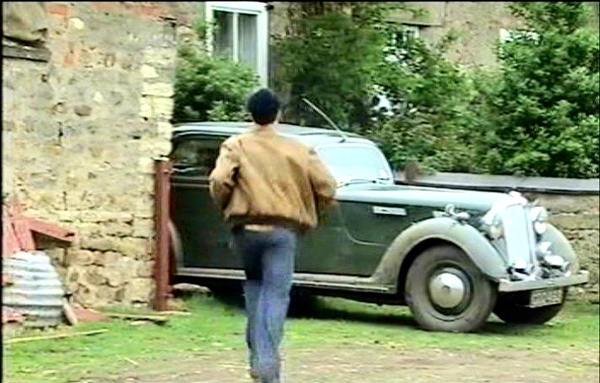Rover 16 P2 "sixteen"
 | |
| Manufacturer | Rover |
|---|---|
| Production | 1937 to 1940 and 1945 to 1948 |
| Predecessor | Rover Speed 16 |
| Successor | Rover P3 |
| Body style | four-door “six-light” saloon four-door “four-light” "sports saloon" two-door cabriolet |
| Engine | 2147 cc straight 6 |
| Wheelbase | 113 in (2,870 mm) |
| Length | 175 in (4,445 mm) |
| Width | 62.5 in (1,588 mm) |
The Rover 16 was a medium-sized family car produced by the British Rover car company between 1937 and 1940 as a successor to the Rover Speed 16. It reappeared in 1945 following the Second World War and remained on sale until replaced by the Rover P3 in 1948.

The car, with its mildly streamlined form, resembled the existing Rover 10 and the Rover 12 but was slightly longer and featured a more rounded back end. The six-cylinder ohv engine had a capacity of 2,147 cc. A top speed of 124 km/h (77 mph) was claimed. In addition to the four-door saloon, a two-door cabriolet was available, normally referred to as a drophead coupé, with bodywork by Tickfords.The Coachbuilt saloon with flush-fitting sliding roof; finished in maroon with maroon wheels and selected hide seating. Equipment
includes: chromium-plated head, side and fog lamps; electric dual wind-screen wipers; centrally controlled windscreen; Triplex glass throughout; ventilating louvres fitted to top of door windows; built-in direction indicators with automatic return; electric horn; trip speedometer; clock; ammeter; oil pressure gauge; combined electric petrol and oil level gauge; interior light; driving mirror; smokers' ash trays; central folding and side arm rests to rear seats; body pulls; interior sun visors; mirror in near-side visor; roof parcel net; driver-operated rear window blind; harmonic stabiliser; bumpersat front and rear; built-in luggage compartment at rear; spare wheel and tyre; twin, tail and stop lights; tool. kit in rubber moulded tool drawer under dash; D.W.S. hydraulic jacking system.
The "Sixteen" 6-Cylinder ROVER Saloon.Engine flexibly mounted, 67.5 mm. bore 100 mm, stroke (Treasury rating 16.9 h.p.); overhead valves; pump water circulation; lubrication by gear type pump; chassis lubricated automatically by Bijur system; coil and battery ignition; ventilated dynamo; Lucas electrical equipment. For Drive,4 speeds and reverse easy-change gearbox; (silent engagement) freewheel controlled from dashboard' operates on all forward gears; central remote gear-change lever; single-plate clutch; open propeller shaft; spiral bevel final drive; worm and nut steering.
The sports saloon and the drophead coupé had slightly less length between the front and rear seats, but a longer bonnet, with the front footwell extending further beneath the bonnet with flush-fitting sliding roof, finished green with green wheels and selected hide seating. Equipment includes: chromium-plated head, side and fog lamps; electric dual windscreen wipers; centrally controlled windscreen; Triplex glass throughout; ventilating louvres fitted to top of door windows; built-in direction indicators with automatic return; electric horn; trip speedometer; clock; ammeter; oil pressure gauge; combined electric petrol and oil level gauge; interior light; driving mirror; smokers' ash trays; central folding and side arm rests to rear seat; driver-operated rear window blind; interior sun visors; mirror in near-side visor; body pulls; harmonic stabiliser; bumpers at front and rear; built-in luggage compartment at rear; spare wheel and tyre; twin, tail and stop lights; tool kit in rubber moulded drawer under dash; D.W.S. hydraulic jacking system.
A version called the Rover 14 saloon combined the same body with (from 1938) a 1,901 cc six-cylinder engine. There was also a version called the Rover 20 with a 2512 cc. engine.

Notable features included a "freewheel" system, Bijur-Luvax automatic lubrication of the chassis, and Girling rod actuated fully compensated mechanical brakes of exceptionally high efficiency.Fitted with Girling balanced. mechanical brakes on all 4 wheels; 17 x 5.5 Avon Duo-Tread tyres; detachable wire wheels; half-elliptic springs front and rear; hydraulic shock absorbers front and rear; underslung chassis; box section cross members on a wheelbase of 9 ft 7 in and track 4 ft. 4 in.
The Rover 16 saloon returned to production almost unchanged after the war, although the cabriolet version was no longer listed.

A Rover 16 in Heartbeat, TV Series.

Rating
Technical
-
Rover 16 P2 Technical details and specifications (1937-1948)
ENGINE:2,147cc
No. of Cylinders - 6
Treagury Rating -16.9 h.p.
cc - 2,147
Bore - 67.5mm
Stroke - 100 mm.
Compression Ratio - 6-1
Firing Order - 1-5-3-6-2-4
Carburettor make -1937-1939 S.U. B.P. Needle 1939 SU D/D 1940 Solex FFIACLUTCH AND GEAR BOX:
Clutch type - Single Dry Plate
Type of facing - Fabric
Gear ratio, top - 4.7—1
Gear ratio, third - 7.14—1
Gear ratio, second - 10.62—1
Gear ratio, first - 18.98—1FRONT AXLE AND STEERING
Turning circle - 40ft.
Wheel base - 9ft. 7in.
Tyre size - 5.50 x 17in.REAR AXLE:
Type of axle - Semi-floating
Type of drive - Spiral bevel
Ratio - 4.7 to 1BRAKES:
Type - Girling
Type of linings - MouldedSPRINGS:
Type -F. 1/2 Elliptic—R. 1/2 Elliptic
Length—Front - 33in.
Length—Rear - 45 1/4in.ELECTRICAL:
Battery type - V.12 A.H. 51
Battery earth—pos. or neg - Positive© Motor car History
-
Rover 16 P2 Service Guide (1937-1948)
Distributor rotation - Anti-clock
Manual advance - 20° on Octane Selector
Breaker Gap - .012in.
Plug make - Lodge
Plug Gap - .018in.CAPACITIES:
Sump—pints - 13
Gear Box—pints - 3
Rear Axle—pints - 3 1/4
Radiator - 22 pints
Petrol-—galls. - 12-Rover 16 P2 Advanced Maintenance is available for registered users-
© Motor car History





